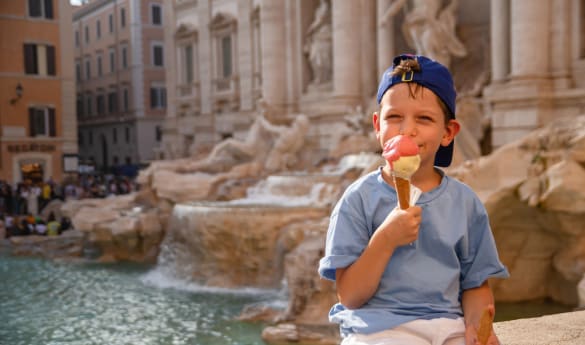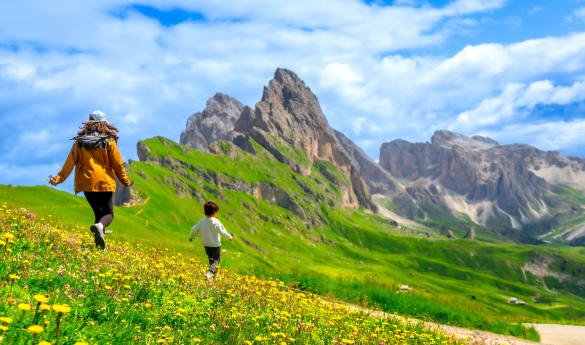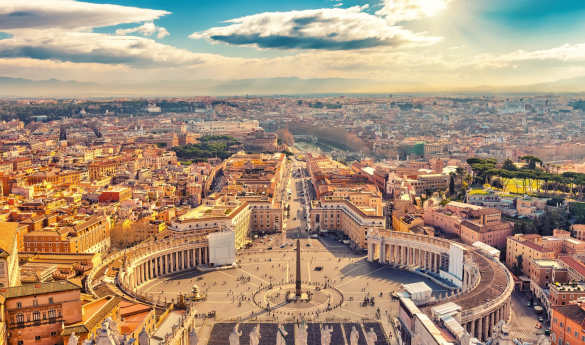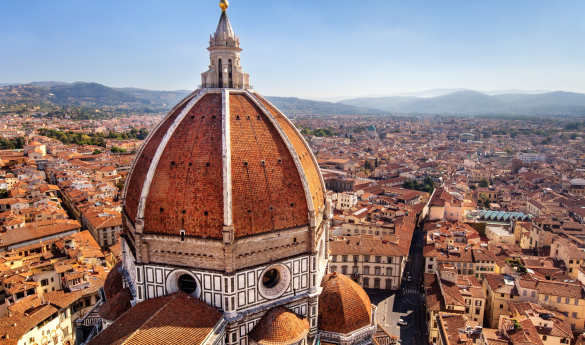10 Incredible UNESCO World Heritage Sites in Italy You Must Visit
The chance to escape to Europe is the chance to escape to the past with a visit to one of Italy’s incredible UNESCO World Heritage sites. Here are our top picks.
09 June 2023

Italy is so rich with artistic, architectural, and natural wonders, it's no surprise that the country has more UNESCO World Heritage sites than any other in the world. Since 1972, UNESCO has selected more than 1,000 cultural and natural places “of universal value” around the world and added them to their list. It’s not just about the trophies; World Heritage status means the country commits to protecting and preserving these treasured areas for future generations.
Resplendent cities dripping with history, coastlines dotted with multi-colored houses, ancient frescos and churches – these are just some of the 58 World Heritage sites in Italy. And, this year, the country has its sights set on its 59th, by nominating its food to be officially recognized by UNESCO too.
There are the places you’d imagine to be on the list, like Florence, Rome, Pompei and Herculaneum, the Amalfi Coast; and then there are the lesser known, but equally charming additions, like Puglia’s village of Alberobello known for its fairytale trulli, the home of Prosecco in northern Italy, Matera’s monasteries built into caves, and the eight towns that makeup Val di Noto in Sicily.
You’d be silly not to see a UNESCO World Heritage site on your trip to Italy. However, to help you narrow it down, we’ve selected 10 of the best.
Italy’s Best UNESCO World Heritage Sites
We asked our travel experts to share their favorite World Heritage sites in Italy. We’ve added a mix of the classics for first-time visitors and some more off-the-beaten-track locations for Italy aficionados. Whether it’s your first or your millionth trip to this beautiful country, you will find something on this list that will grab your attention.
1. The Colline del Prosecco di Conegliano e Valdobbiadene, Veneto

Lying just north of Venice, this is the region of Italy that grows grapes for Prosecco sparkling wine. Lush green vines decorate the hilly area creating the illusion of a striped landscape. Italians have used this land for viticulture as far back as the 17th century and it is still mostly family-run businesses that churn out delicious versions of the Veneto region’s best-known wine. An idyllic, largely undeveloped wine industry set in stunning surroundings awaits and it’s not just the oenophiles among you that will enjoy dipping in and out of open cellar doors and exploring cobbled stucco villages. The scenery is so captivating, it’s worth visiting for that alone. Head to the region in the fall (September and October) to experience the buzz of the harvest, where you’ll see grapes being picked and many festivals happening around the region.
How to get there: Fly from America to Venice, to admire this UNESCO site in Italy. Colline del Prosecco di Conegliano e Valdobbiadene is just an hour away and makes a perfect day trip from the city. Scott Dunn will organize all transfers and your tour guide so all you have to do is admire the scenery.
Where to stay: We love Baglioni Hotel Luna or Hotel Cipriani, they are two of Venice’s most iconic, grand dame hotels.
2. Matera

Often described as one of Italy’s hidden treasures, Matera is in the southern Italian region of Basilicata just next door to Puglia. It is one of the oldest inhabited cities in the world and is made up of rock-cut caves in which its citizens traditionally lived. Having been derelict for years, the area has now been brought back to life and this dramatic landscape is having its moment in the limelight. Inside the caves and all over the hillside, chic hotels and delightful restaurants are popping up, year after year.
Italy's World Heritage sites the Sassi and the Park of the Rupestrian Churches of Matera incorporate a collection of houses, churches, monasteries, and shelters built into the natural caves of Murgia National Park, which date back to Paleolithic times. Tour the area with a private guide to hear fascinating stories of its rich history. April, May, June, and September are the best times to visit Matera. In the summer months of July/August it can get very hot, and you face peak prices.
How to get there: The nearest airport to Matera is Bari, which is an hour away. Flights to Bari from the US tend to go via London or Rome. Scott Dunn will organize all your flights and transfers, ensuring a smooth and easy arrival into the city.
Where to stay: Sextantio le Grotte della Civita gives you a sample of cave living, brought into the modern day with a whole lot of comfort and luxury.
3. Villa Adriana, Tivoli, Rome

You don’t have to be a history buff to appreciate the splendor of Emperor Hadrian’s beautiful county estate. He retreated here towards the end of his reign, having taken inspiration from his empire to build it. Drawing on architectural elements from Egypt, Greece, and Rome, this complex of classical buildings was constructed in the form of Hadrian's 'ideal city'. Though not much of the villa itself still stands, the archeological remains and 18th-century statues that are there create an awe-inspiring and important historical site in Italy. Plus, the nearly 200-acre garden is perfect for a stroll. To avoid overcrowding and soaring temperatures, visit Villa Adriana in April, May, June, September, or October.
How to get there: Fly from the USA to Rome, then it’s an hour’s drive out into the countryside. This is the perfect day trip to get a break from Italy’s bustling capital city.
Where to stay: For old-school glamor stay in one of our favorite hotels in Rome Hotel De La Ville, Villa Spalletti Trivelli, or Portrait Roma.
4. Val di Noto, Sicily

Val di Noto in south-eastern Sicily is made up of eight late baroque towns, which are combined to make one of Italy’s World Heritage Sites. Some of the names you might recognize as locations in the award-winning HBO series White Lotus, they include:
- Caltagirone
- Militello Val di Catani
- Catania
- Modica
- Noto
- Palazzolo Acreide
- Ragusa
- Scicli
Incredible ancient ruins are dotted amongst beautiful, unspoiled coastlines with secluded beaches. You barely need to try to sightsee here, you’ll just find yourself surrounded by neo-classical, baroque, and gothic palazzos, castles, and amphitheaters all over the region. The restaurants in this region are lip-smackingly good too!
Sicily is beautiful all year round. For sun worshippers, the beaches are ideal in the summer months – June to August. However, those who like less crowds should go in spring; April and May. If it’s the architecture you’re visiting for, then fall (September and October) has a pleasant climate too.
How to get there: The easiest way is to fly into Catania, which is just over an hour from Noto, though many international flights land in Palermo (three hours away).
Where to stay: Base yourself in Noto staying at Q92, Ragusa’s Ill San Corrado di Noto, or for the full White Lotus experience stay at Four Seasons San Domenico Palace, an hour from Catania in Taormina, and the location for filming in series 2.
5. The Porticoes of Bologna, Bologna

An important cultural and architectural heritage, Bologna’s beautiful archways are symbolic of the city, along with its red rooftops and several leaning towers. They are one of Italy's newest UNESCO World Heritage sites, having been awarded the status in 2021. Together, the porticoes of Bologna cover more than 23 miles in the historic center. Stroll through these beautiful ochre, arched colonnades, nipping into chic boutiques, or stopping for an aperitivo. Of course, all of Italy is famous for its food but Bologna is the culinary heart of Emilia-Romagna and has earned the nickname La Grassa (meaning ‘the fat one’). Arrive hungry and don’t leave without sampling some of the local specialties, such as Bolognese sauce, tortellini, mortadella (a tasty sausage), crescentine (a filled flat-bread pocket), tagliere (cold cuts and cheese), balsamic vinegar, and Parma ham.
The city comes alive in spring (April to June), with outdoor events, festivals, and blooming gardens. It's a great time to explore the historic sites, wander through the porticoes, and indulge in the local food scene. It can get hot and crowded in summer (July and August), but there’s always a cold gelato in the outdoor piazzas to cool you down, while fall brings milder temperatures and fewer people, plus the autumn foliage adds a beautiful touch to the city's landscapes.
“One of my best memories of traveling in Italy was eating a freshly sliced mortadella sandwich (from the famous spot Mo Mortadella Lab) in Bologna while strolling under the famous porticoes.” Livia Angelini (Italy Travel Expert, Scott Dunn)
How to get there: Most flights from the USA will include a changeover in Europe before traveling on to Bologna.
Where to stay: Head to the Hotel Corona d’Oro or Grand Hotel Majestic for a stay in ultimate luxury.
6. Cinque Terre, Liguria

Hugging the rugged Italian Riviera coastline, the enchanting region of Cinque Terre beckons travelers with its postcard-perfect villages and breathtaking views. A cascade of pastel-colored houses cling to cliffs, overlooking sparkling azure waters below. Each of the five villages which make up this Italian historical site, Monterosso al Mare, Vernazza, Corniglia, Manarola, and Riomaggiore, possesses its own unique charm, inviting exploration at every turn. It is the beauty of these linked towns that have them noted as a cultural landscape of extraordinary value by UNESCO. Hiking enthusiasts are treated to an unforgettable experience as they traverse the famous coastal trail, where sweeping panoramas appear with every step. With incredible seafood, crisp local wines, and sun-soaked idyllic pebbled beaches, Cinque Terre has it all.
How to get there: The most convenient airport for Cinque Terre is Pisa, however, you can also fly to Florence. Most major airports in the USA offer flight options to both cities.
Where to stay: Portofino is a popular place to base yourself to explore the Cinque Terre region. Stay at Belmond Hotel Splendido or Eight Hotels Paraggi.
7. The Dolomites

With towering peaks, dramatic rock formations, and picturesque valleys, the Dolomites, a UNESCO World Heritage site in the Italian Alps, attract adventurers from all over the world. Hiking through vibrant alpine meadows, past clear lakes, and under snow-capped summits is a popular activity here in the summer (May to August), while skiing takes over in the winter and early spring (December to April). The region is known for its charming mountain villages, rich in cultural heritage, where time seems to stand still, and traditions are celebrated with zest. But it isn’t just the exceptional beauty of the mountains that won the Dolomites a position as Italy’s UNESCO World Heritage site, they also hold significant scientific value as they provide insights into the Earth's geological history, including the formation of coral reefs and fossil records. Whether you are seeking outdoor thrills or peaceful moments in nature, a visit to the Dolomites is an unforgettable experience that showcases the beauty of these majestic mountains.
How to get there: Fly into Venice, before transferring to your mountain retreat. We like to pair vacations in the Dolomites with a stay in Lake Garda or head on to Greece’s Peloponnese peninsula for active families.
Where to stay: The entire region spans 86 miles from east to west, so you are spoilt for choice with hotels. Some of our favorites are Alpina Dolomites for the winter and Hotel Tyrol in the summer.
8. Florence

Located in idyllic Tuscany, Florence is one of Italy’s masterpieces. Proudly holding the title of an Italian UNESCO World Heritage site, this enchanting city is a testament to human achievement and artistic brilliance. Its streets, adorned with architectural wonders and historical treasures, paint a vivid picture of the Renaissance era. From the awe-inspiring Duomo to the iconic Ponte Vecchio and the world-renowned Uffizi Gallery, Florence encapsulates a legacy that shaped Western civilization. Exploring its winding streets reveals palaces, museums, and churches adorned by legendary artists such as Michelangelo, Leonardo da Vinci, and Botticelli. Along the Arno River, soak up the city's vibrant culture and savor the flavors of Tuscan cuisine. Florence is an immersive journey into history, art, and gastronomy, and the romance and beauty of the city has captivated the imaginations of travelers from across the globe for centuries. Visit Florence in spring (March-May) or fall (September-November) to see it in its best light.
How to get there: Flights from the USA don’t fly direct to Florence; however, you can connect in Rome and combine a stay in another of Italy’s breathtaking cities. To find out more, look at our Ultimate Italian Cities itinerary.
Where to stay: The Continentale overlooks Ponte Vecchio, while Belmond Villa San Michele has to be one of the most romantic hotels in the world.
9. Alberobello, Puglia

As soon as you step foot into the whimsical fairytale land of Alberobello, this extraordinary village will have you charmed. Italy’s UNESCO World Heritage site in Puglia, with its iconic Trulli (traditional limestone dwellings with conical roofs), seems almost plucked from the pages of a storybook. Strolling through the narrow streets, you’ll be transported to another era, where time-honored traditions and authentic charm still thrive. The Trulli, with their whitewashed walls and distinctive architectural style, are not just exquisite to look at but are an example of the ingenuity shown by its inhabitants. Their cone-shaped roofs were designed to collect rainwater and channel it into underground cisterns, providing a vital water source for the residents. While the thick stone walls provided excellent insulation, keeping the interiors cool in the summer and warm in the winter.
As the sun casts a golden glow over this enchanting landscape, it's easy to see why Alberobello is hailed as a living museum. Lose yourself in the maze-like alleys, explore the unique Trulli interiors-turned-boutiques, and savor the local flavors. Alberobello is a magical place that will add a sprinkling of fantasyland to your vacation.
This part of Italy is beautiful to visit between April and October.
How to get there: Bari and Brindisi are the closest airports to Alberobello, both have connecting flights and trains from Rome.
Where to stay: Stay at the enchanting Borgo Egnazia or Masseria Torre Maizza to explore all that Puglia has to offer.
10. Pompeii & Herculaneum

Journey back in time to the remarkable archaeological sites of Pompeii and Herculaneum, frozen in volcanic ash and preserved for centuries. This Roman UNESCO site in Italy, at the foot of Mount Vesuvius, offers an extraordinary window into the daily life and tragic demise of the inhabitants. Step onto the ancient streets of Pompeii, where time stands still amidst the haunting ruins of homes, temples, and marketplaces. Witness the meticulous preservation of frescoes, mosaics, and grand villas that showcase the opulence of Roman society. A short distance away, Herculaneum reveals its own compelling story, with its pristine villas and intricately preserved wooden structures. Wander through the remnants of this once-thriving coastal town, marveling at the exquisite craftsmanship and unparalleled insight into Roman urban life. Pompeii and Herculaneum are timeless reminders of the devastating power of nature and the enduring spirit of human civilization.
How to get there: Spend a day exploring Pompeii when staying on the Amalfi Coast. Fly into Naples directly from New York, Miami, and Philadelphia or other major US airports via stops in various Italian and European cities.
Where to stay: Positano and Sorrento are about an hour from Pompeii, stay at the cliff-top Hotel Sirenuse for Michelin-star food or Hotel Palazzo Murat to feel like royalty.
This entry was posted in and tagged Italy.
Start Planning Your Trip Today
Ready to start seeing the sites? Then reach out to our travel specialists today to start planning your perfect Italy vacation. If you’re still looking for inspiration, then check out some of our planned itineraries below.
Filter
Call us on 858 345 1764 to start planning


















